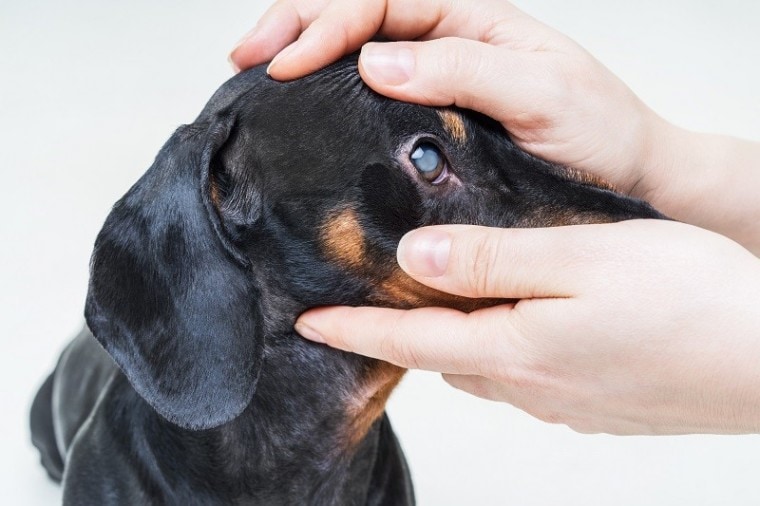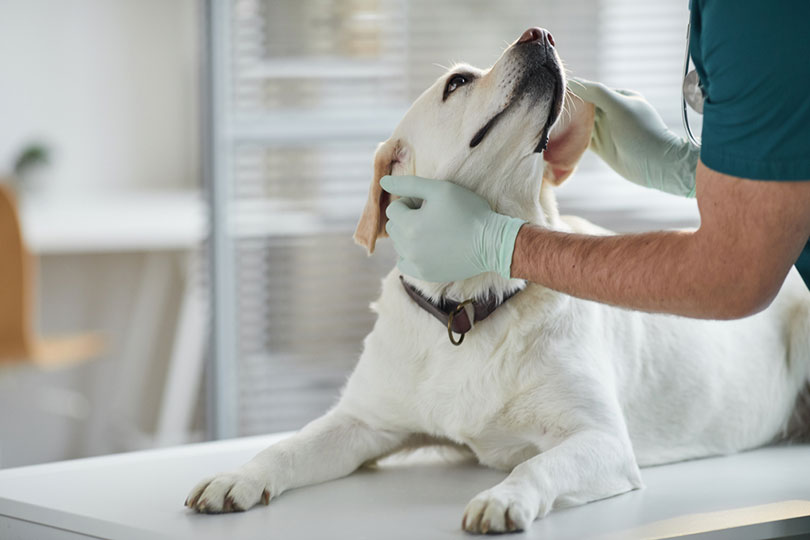
[ad_1]

Introduction
If your pet is blessed with a long life, the chances are high that they’ll eventually develop cataracts. These white fibrous specks in your dog’s eye can severely impair their vision and lead to blindness if not treated. If your vet determines your dog is a good candidate for cataract correction surgery, you should consider the procedure to help your friend live life to its fullest. Here are some things you’ll need to know about dog cataract surgery, including how much it costs, when it’s necessary, and if a pet insurance policy would cover it.

Why Would Your Dog Need Cataract Surgery?
Senior dogs will develop a hazy, bluish tint on their eyes that is commonly mistaken for cataracts. This condition is actually called lenticular or nuclear sclerosis. Unlike cataracts, it’s a normal part of aging and doesn’t significantly impede your dog’s vision. Although it appears blue, the film is mostly translucent, which means your dog can see through it.
Cataracts, on the other hand, are white fibers that form on the inside of the eye’s lens. These aren’t transparent, so they obstruct your dog’s vision and can lead to eventual blindness if allowed to progress.
Your vet will need to conduct an eye exam to determine whether your dog has cataracts or nuclear sclerosis. Since nuclear sclerosis is a normal part of aging, there will likely be nothing your veterinarian can do to fix the problem. They may recommend surgery if cataracts are present; however not all dogs are good candidates based on their age and medical history. For example, cataract surgery is too risky for dogs with a detached retina.
How Much Does Dog Cataract Surgery Cost?

Surgery costs hover around $2,500 and $4,000, with $3,500 as the average amount to expect. This includes everything typically associated with the procedure, such as the preliminary examination, ERG and ultrasound to make sure your dog’s retina is functioning properly, anesthesia, the surgery itself, medications, and post-operative care. It’s important to note that this is the expected cost per eye. If your dog has cataracts in both eyes, you can expect to pay anywhere from $3,000-$6,000 total.
The exact price depends on your veterinary clinic, your dog’s breed, and even where you live as medical care tends to be more expensive in urban areas and along the east and west coasts.

Additional Costs to Anticipate
Surgery is always a little risky because of the anesthesia, but cataract surgery is generally safe as long as your vet deems your dog a good candidate for cataract surgery. This operation is very risky for dogs with glaucoma or a detached retina, which is why your vet will want to rule out these conditions before the operation through the ultrasound and screening process.
Cataract surgery is generally an easy and effective procedure, with a success rate of 90% after the first year. Some dogs will even begin to see better after the first day, but others might take a few weeks to adjust to their new artificial lens.
Even if there are no complications, you want to invest in an E-collar cone post-operation to make sure your dog doesn’t accidentally injure their eyes. They’ll need to wear it for the first two weeks following surgery. In the meantime, you should limit your dog’s physical activity to walking, and continue to give them their prescribed medication, such as eye drops.
At the end of the two-week time period, your vet will want to see your dog for a follow-up appointment to make sure they’re recovering normally.
Does Pet Insurance Cover Dog Cataract Surgery?

It’s important to secure a pet insurance policy before you need it. Like human health insurance, pet insurance won’t cover pre-existing conditions, so if you’ve already received a diagnosis unfortunately it’s too late to reach out to these companies for help.
Not all pet insurance companies cover cataract surgery, but some will pay up to 90% of the costs depending on your policy. Healthy Paws and Embrace both offer plans that will pay for your dog’s cataract surgery, as long as cataracts weren’t a pre-existing condition at the time of enrollment.
How to Take Care of Your Dog’s Vision
Unfortunately, some dog breeds seem genetically predisposed to cataracts. Poodles, American Cocker Spaniels, and the Labrador retriever seem particularly susceptible. However, sometimes cataracts develop as a consequence of a fairly preventable disease, such as diabetes mellitus. These cataracts tend to progress faster than ones with a genetic origin, so it’s important to make sure your dog stays healthy so that you can mitigate the risk.
Ensuring your dog chows down on a well-balanced diet and receives an amount of exercise appropriate for their age and breed can help reduce the risks of chronic illnesses such as diabetes. While they may not prevent cataracts, you can also give your dog a multivitamin to boost their vision health or feed them carrots to supply them with beta carotene.

Conclusion
Not all cataracts behave aggressively, and some may even stagnate. If your vet decides the cataract isn’t appearing to develop quickly and there are no underlying symptoms, you might discuss the pros and cons of surgery with them at length.
You may decide that cataract surgery is quite honestly an expensive surgery that might not be worth the money and risk, especially if your dog is already advanced in years. However, if you have a fairly young pup, you might want to seriously consider going forward with the surgery so that you can save their vision and give them a better quality of life for the years ahead.
Cataract surgery costs between $2,500 and $5,000 depending on your dog’s condition and where your vet is located. Some pet insurance companies such as Healthy Paws and Embrace will cover up to 90% of the surgery costs, as long as vision problems weren’t a pre-existing condition at the time of enrollment.
Featured Image Credit: Masarik, Shutterstock
[ad_2]
Source link

